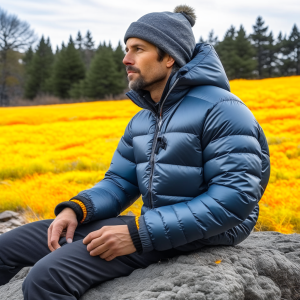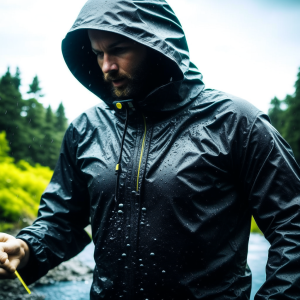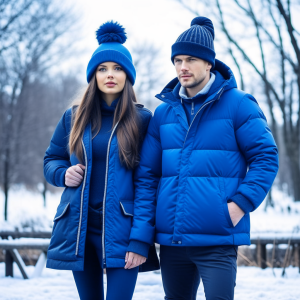Master Layering Techniques for Ultimate Warmth and Fashion in Cold Weather
As winter envelops us in its chilling embrace, the challenge of finding attire that balances both warmth and style becomes crucial. With falling temperatures, the necessity for effective layering arises, but have you ever considered the intricate principles of layering? In this comprehensive guide, we will explore the fundamentals of cold-weather layering, revealing the strategies that differentiate high-performance garments from the rest, ensuring you remain both cozy and fashionable amidst the biting cold.
Layering isn’t just about aesthetics; it’s a strategic method for enhancing heat retention and comfort during subzero conditions. When the mercury drops, our bodies instinctively attempt to preserve warmth by narrowing blood vessels, leading to discomfort in extremities like hands and feet. Yet, this natural mechanism often falls short. Here, we delve into the science behind layering, which allows us to create an effective insulating barrier against the cold while maintaining freedom of movement and overall comfort.

Establishing a Strong Base Layer: The Cornerstone of Cold Weather Attire
The base layer is the fundamental building block of your winter wardrobe, designed to fit snugly against the skin while delivering essential insulation. To appreciate the importance of this layer, we must delve into the science of moisture management and its crucial role in maintaining warmth and comfort throughout the icy months ahead.
Utilizing Moisture-Wicking Fabrics for Superior Comfort and Dryness
Choosing the right fabric for your base layer is vital for effective moisture management. The significance of moisture-wicking capabilities cannot be overstated. These specialized fabrics are engineered to draw moisture away from your skin, whether from perspiration or external dampness, thereby preventing the buildup that leads to discomfort. A premium base layer not only acts as a barrier against moisture but also ensures you stay dry and snug, even under challenging weather conditions, dramatically enhancing your warmth and overall comfort.
Evaluating Insulation: The Benefits of Merino Wool and Synthetic Fibers
Next, let’s examine how materials like merino wool and synthetic fibers enhance the insulating properties of your base layer. Merino wool is renowned for its natural warmth and breathability, making it an exceptional choice; it effectively insulates while also pulling moisture away from the body. On the other hand, synthetic materials such as polyester and nylon offer an ideal blend of durability and insulation, forming a warm micro-environment next to your skin that efficiently traps body heat, keeping you comfortable even in the harshest conditions.
Achieving Optimal Fit: Essential Insights for Base Layer Performance
Selecting the right fit for your base layer extends beyond picking your usual size; it’s about optimizing performance. A snug-fitting base layer ensures consistent contact with your skin, enhancing its insulating and moisture-wicking effectiveness. However, achieving the perfect balance is key—too tight can restrict movement and comfort, while too loose may hinder functionality. When evaluating fit, consider the type of activity and your overall layering strategy to guarantee seamless integration with your other winter garments.
Ultimately, the base layer transcends simple clothing; it serves as an advanced moisture-wicking and insulating barrier against the harsh winter environment. By grasping the unique properties of materials such as merino wool and synthetic fibers, and mastering the fit, you can elevate your base layer from a basic clothing item to a critical element in your defense against the cold.
Optimizing Your Insulating Layer: The Key to Retaining Body Heat Effectively
 As we shift our focus to the insulating layer, we highlight its pivotal role in capturing and retaining heat around your body. This layer is essential in the science of heat retention, acting as a protective cocoon against harsh winter conditions. Let’s explore critical elements such as warmth-to-weight ratios, the benefits of down insulation, and the eco-friendly advantages of synthetic alternatives.
As we shift our focus to the insulating layer, we highlight its pivotal role in capturing and retaining heat around your body. This layer is essential in the science of heat retention, acting as a protective cocoon against harsh winter conditions. Let’s explore critical elements such as warmth-to-weight ratios, the benefits of down insulation, and the eco-friendly advantages of synthetic alternatives.
Understanding Warmth-to-Weight Ratios for Effective Insulation Choices
Grasping the concept of warmth-to-weight ratios is crucial when selecting an insulating layer. This principle underscores the importance of insulation materials that provide exceptional warmth without unnecessary bulk. It’s about achieving the highest warmth level while minimizing weight, ensuring you can move freely and comfortably. This balance is particularly important for individuals who require insulation without feeling weighed down, allowing for unrestricted movement in cold conditions.
The Benefits of Down Insulation: Lightweight Warmth for Outdoor Adventurers
Down insulation stands out as a top choice for those seeking unparalleled warmth in a lightweight form. Sourced from the soft feathers of ducks and geese, down is celebrated for its superior warmth-to-weight ratio. Its light and compressible characteristics make it a favored option among winter explorers who need effective insulation without compromising mobility. Understanding the allure of down insulation is integral to appreciating its role in crafting an insulating layer that harmonizes warmth, comfort, and flexibility.
Selecting Synthetic Insulation: Ethical Warmth for Varied Conditions
Synthetic insulation materials, primarily made from polyester fibers, have become popular ethical alternatives in the insulation landscape. What sets synthetic insulation apart is its ability to retain heat even in wet conditions, a feature where down may falter. This resilience in unpredictable climates makes synthetic options ideal for diverse weather scenarios. Moreover, choosing synthetic materials aligns with ethical considerations, allowing you to enjoy warmth without compromising your values.
Choosing the Right Thickness: Precision in Insulation Selection
Selecting the appropriate thickness for your insulating layer requires careful thought; precision is critical. Evaluate the expected cold exposure in conjunction with your layering strategy when determining thickness. In milder climates, a thinner insulating layer may suffice, while extreme conditions might necessitate a thicker, more robust alternative. By comprehending the nuances of insulation thickness, you can customize your insulating layer to cater to the specific demands of your winter adventures.
In essence, the insulating layer transcends traditional clothing functions, evolving into a strategic partner in the battle against the cold. By deciphering warmth-to-weight ratios, celebrating the advantages of down insulation alongside synthetic options, and offering guidance on thickness selection, we transform the insulating layer into a calculated defense mechanism against winter’s icy grasp.
Your Outermost Layer: The Ultimate Barrier Against Frigid Winds and Elements
The outermost layer acts as your essential shield against biting winds and freezing temperatures. This layer fulfills dual roles: it protects against harsh environmental conditions while significantly contributing to moisture management. By diving deeper into the outer layer, we will uncover the importance of breathability, the transformative advantages of DWR finishes and Gore-Tex membranes, and the essential windproof features that enhance insulation performance.
Breathability: The Foundation of Comfort and Effective Moisture Control
Often underestimated, breathability is a critical aspect of the outer layer that greatly affects overall comfort. This attribute refers to the fabric’s ability to allow sweat vapor to escape from your body while preventing outside moisture from penetrating. Achieving this delicate balance keeps you dry and comfortable, mitigating the chilling effects of trapped moisture. A breathable outer layer is essential for maintaining a cozy microclimate within your clothing, ensuring incredible comfort during adverse weather conditions.
DWR Finishes and Gore-Tex: Leading Innovations in Waterproofing
 DWR (Durable Water Repellent) coatings and Gore-Tex membranes are at the forefront of cold-weather outerwear technology. DWR finishes equip fabrics with water-repellent capabilities, creating a reliable barrier against rain, sleet, and snow. Gore-Tex and similar technologies elevate waterproofing, offering an ideal blend of impermeability and breathability. Understanding the interplay between these technologies is vital for staying dry and comfortable, even in the harshest weather.
DWR (Durable Water Repellent) coatings and Gore-Tex membranes are at the forefront of cold-weather outerwear technology. DWR finishes equip fabrics with water-repellent capabilities, creating a reliable barrier against rain, sleet, and snow. Gore-Tex and similar technologies elevate waterproofing, offering an ideal blend of impermeability and breathability. Understanding the interplay between these technologies is vital for staying dry and comfortable, even in the harshest weather.
Windproof Features: Maximizing Protection Against Icy Winds
Windproof properties are essential for frigid conditions, especially when biting gusts can penetrate even the strongest fabrics. The windproof outer layer acts as an impenetrable barrier against cold air, enhancing comfort while safeguarding the insulation of the inner layers. By blocking frigid winds, your outer layer becomes a formidable protector, ensuring your carefully curated layers work harmoniously to keep you warm and shielded from harsh elements.
In summary, the outermost layer is more than a simple protective shell; it represents a sophisticated barrier that expertly balances breathability and waterproofing. By understanding the significance of breathability, exploring innovations like DWR finishes and Gore-Tex membranes, and recognizing the importance of windproof features, we elevate the outer layer into a versatile garment that excels in style, functionality, and weather resistance.
Actionable Strategies for Achieving Maximum Warmth and Style This Winter
With a solid understanding of effective layering established, let’s delve into practical tips and strategies to elevate your cold-weather experience, effortlessly merging warmth with enduring style. Accessories are pivotal in winter attire, often serving as the unheralded champions that can elevate your outfits. From the essential warmth provided by thoughtfully selected gloves to the stylistic appeal of a cozy hat and the comfort of thermal socks, these seemingly minor details are crucial for achieving a fashionable and comfortable winter ensemble.
The Critical Role of Accessories: More Than Just Aesthetic Enhancements
Accessories serve more than decorative purposes; they are vital components in your defense against the cold. Beyond their visual allure, items like gloves, hats, and thermal socks play significant roles in boosting your overall warmth. By strategically incorporating these accessories, you can ensure every part of your body is shielded from the chill, effectively preventing valuable body heat from escaping into the frigid atmosphere.
Investing in Quality Accessories: Recommendations for Ultimate Warmth and Comfort
The pursuit of warmth extends beyond your base and insulating layers; it also includes the thoughtful selection of accessories. Consider investing in high-quality gloves made from insulating materials like fleece or lined leather to form a robust barrier against the cold. A warm hat with extra insulation or a cozy faux-fur lining not only adds a chic touch but also assists in retaining body heat. Choose thermal socks crafted from merino wool or advanced synthetic materials to ensure maximum warmth and effective moisture management.
Fashion-Forward Tips: Merging Functionality with Style This Winter
Staying warm during icy temperatures does not necessitate sacrificing style. Employ these smart styling techniques to navigate the winter landscape with elegance. Experiment with layering various textures in your outfit to create visual depth while enhancing insulation. Opt for winter-appropriate colors that harmonize with the snowy backdrop, and don’t hesitate to accessorize with bold items like a vibrant scarf or chic earmuffs to elevate your overall look.
In essence, accessories are the unsung architects of a well-rounded winter outfit. They not only bolster warmth but also allow you to express your personal style, even in the coldest conditions. By selecting high-quality accessories and enriching your winter wardrobe with thoughtful styling, you can conquer the chill while radiating undeniable elegance.
Embrace the Harmony of Style and Functionality in Your Winter Wardrobe
As we conclude our exploration of overcoming the cold, it’s crucial to acknowledge the significance of style in winter apparel. Dressing for the cold does not mean sacrificing your fashion sense; rather, the current fashion landscape celebrates the fusion of functionality and flair. Numerous outdoor and fashion brands have recognized the need for winter gear that not only provides warmth but also exudes confidence and contemporary sophistication.
The Evolution of Cold-Weather Clothing: A Stylish New Chapter
 The cold-weather clothing industry is experiencing a renaissance, where winter apparel transcends mere functionality to embody a symbol of innovation and style. Designers and brands increasingly recognize the necessity for clothing that effortlessly merges practicality with aesthetic appeal. This shift has ushered in a new era of outerwear that not only provides warmth but also captivates with its visual charm.
The cold-weather clothing industry is experiencing a renaissance, where winter apparel transcends mere functionality to embody a symbol of innovation and style. Designers and brands increasingly recognize the necessity for clothing that effortlessly merges practicality with aesthetic appeal. This shift has ushered in a new era of outerwear that not only provides warmth but also captivates with its visual charm.
Leading Brands: Blending Style and Functionality Seamlessly
Several brands are leading the charge in this style revolution, skillfully merging fashion with functionality in their winter collections. Canada Goose is famed for its luxurious down coats that deliver exceptional warmth without compromising style. The North Face infuses cutting-edge technology into its designs, crafting outerwear that seamlessly balances chic aesthetics with practical utility. Meanwhile, Moncler has redefined the puffer jacket, transforming it into a high-fashion statement piece, proving that winter apparel can be both functional and runway-ready.
Effective Styling Techniques: Elevate Your Winter Fashion Experience
Now, let’s explore how to effectively combine warmth and style in your winter outfits. Opt for standout pieces that serve both functional and aesthetic purposes, such as a beautifully tailored wool coat or a sleek parka that becomes the focal point of your ensemble. Experiment with layering a chunky knit sweater over a fitted jacket for a cozy yet fashionable appearance. Don’t shy away from infusing vibrant colors into your winter look by accessorizing with eye-catching scarves or trendy boots.
In the end, embracing style in the cold is no longer contradictory; it’s a vibrant reality shaped by a dynamic fashion industry. As stylish cold-weather gear emerges, championed by innovative brands, the narrative shifts from mere survival to personal expression. So, immerse yourself in this style renaissance, select pieces that empower you, and redefine fashion amidst the wintry embrace of the season.
The post Cold Weather Clothing Layers: The Science Explained appeared first on Survival Bite.
The Article Cold Weather Clothing Layers Explained: Understanding the Science Was Found On https://limitsofstrategy.com
Comments are closed